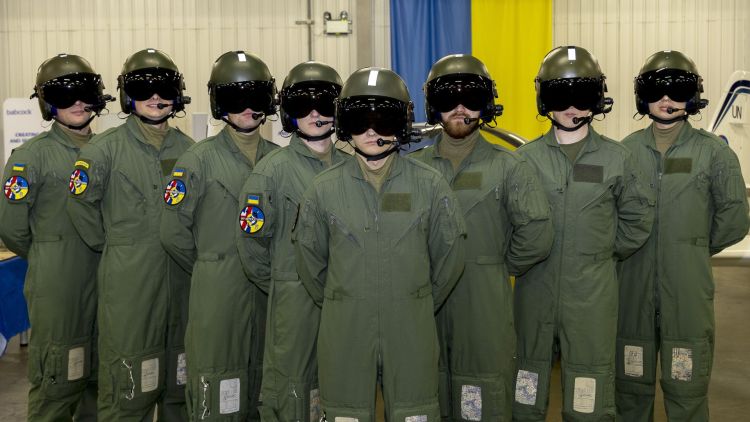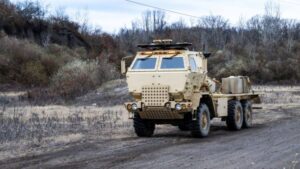The recent graduation of Ukrainian pilots from the United Kingdom’s Royal Air Force Elementary Flying Training (EFT) program marks a major milestone in Ukraine’s preparation for advanced fighter jet operations, specifically with F-16s.
With 200 graduates now trained under the UK’s wing, this accomplishment underscores the growing support from NATO allies as Ukraine fortifies its air defense against Russian forces.
Building an Air Defense Force from the Ground Up
The RAF’s Elementary Flying Training program is the first stage in a three-part initiative designed to transform Ukrainian aviators into F-16-ready pilots.
This initial training phase puts the Ukrainian aviators through their paces on the GROB-115, a propeller-driven aircraft where they log over 70 hours of flight time and practice essential skills in low-level navigation, aircraft handling, formation flying, and instrument-based flying.
The training also includes English language instruction to ensure these pilots can communicate seamlessly with NATO forces, where English is the standard operational language, Kyiv Post reported.
While the UK itself doesn’t operate F-16s, the country has been a staunch advocate of the international Ukrainian Air Capability Coalition (UACC) and has spearheaded these initial training efforts with tremendous dedication.
Lastest graduation batch of Ukrainian pilots from RAF Elementary Flying Training. (Royal Air Force)
After the UK-based training, Ukrainian pilots move on to a more advanced program provided by the French Air Force, where they’ll transition to the Alpha Jet. This light attack aircraft, equipped with a modified instrument panel that closely resembles that of an F-16, will be their bridge to the Fighting Falcon.
Following training in France, the pilots head to Romania, where they’ll complete their F-16 training at the European F-16 Training Center.
The recent graduation of Ukrainian pilots from the United Kingdom’s Royal Air Force Elementary Flying Training (EFT) program marks a major milestone in Ukraine’s preparation for advanced fighter jet operations, specifically with F-16s.
With 200 graduates now trained under the UK’s wing, this accomplishment underscores the growing support from NATO allies as Ukraine fortifies its air defense against Russian forces.
Building an Air Defense Force from the Ground Up
The RAF’s Elementary Flying Training program is the first stage in a three-part initiative designed to transform Ukrainian aviators into F-16-ready pilots.
This initial training phase puts the Ukrainian aviators through their paces on the GROB-115, a propeller-driven aircraft where they log over 70 hours of flight time and practice essential skills in low-level navigation, aircraft handling, formation flying, and instrument-based flying.
The training also includes English language instruction to ensure these pilots can communicate seamlessly with NATO forces, where English is the standard operational language, Kyiv Post reported.
While the UK itself doesn’t operate F-16s, the country has been a staunch advocate of the international Ukrainian Air Capability Coalition (UACC) and has spearheaded these initial training efforts with tremendous dedication.
Lastest graduation batch of Ukrainian pilots from RAF Elementary Flying Training. (Royal Air Force)
After the UK-based training, Ukrainian pilots move on to a more advanced program provided by the French Air Force, where they’ll transition to the Alpha Jet. This light attack aircraft, equipped with a modified instrument panel that closely resembles that of an F-16, will be their bridge to the Fighting Falcon.
Following training in France, the pilots head to Romania, where they’ll complete their F-16 training at the European F-16 Training Center.
This three-phase progression means that, step by step, Ukrainian pilots are building the foundation they need to defend their country’s skies.
A NATO Commitment to Ukraine’s Defense
The international support for Ukraine’s air force is far-reaching.
NATO allies, including the US, Denmark, and the Netherlands, have rallied to form the UACC, which has committed to providing Kyiv with at least 90 F-16 fighter jets.
By early 2025, the coalition aims to assemble two full squadrons, allowing Ukraine to hold its own in the air and, ideally, regain control of its airspace.
These fighters are crucial to Ukraine’s strategy, especially in countering Russia’s advantage in aerial firepower.
In August, Kyiv received its first batch of F-16s from allied countries. This initial delivery, though symbolically powerful, isn’t enough to significantly impact the battlefield just yet.
However, it marks the beginning of a broader, coordinated effort to bolster Ukraine’s military capability in a way that’s truly sustainable.
Ukraine’s F-16s are not only stocked with air-to-air missiles like the AIM-120 AMRAAM but are also equipped with the technical support they’ll need to integrate into Ukraine’s existing defense systems.
UK Royal Air Force Elementary Flying Training (Royal Air Force)
The Importance of Ongoing Pilot Training
The sheer number of Ukrainian pilots now in advanced training programs is significant, but the journey has not been without its challenges.
Language barriers, especially with English-language manuals and training material, have proven to be obstacles.
Some Ukrainian pilots trained in Denmark have struggled with these materials, making it clear that training adaptability is essential. This need for adaptability is also reflected in the US decision to prioritize training younger cadets over seasoned pilots, as the younger cohort is often more flexible in adopting new systems and techniques.
The training process is intense and can be perilous.
Tragically, one of Ukraine’s first F-16-trained pilots, Oleksiy “Moonfish” Mes, lost his life in August while defending against a Russian missile strike. This incident highlights the risks associated with rapid training and underscores the urgency of thoroughly preparing Ukraine’s pilots before sending them into high-stakes combat situations.
Yet, despite these challenges, the coalition’s commitment remains firm.
What This Means for Ukraine’s Battle Against Russian Aggression
With these new skills, Ukraine’s pilots will be much better equipped to handle the fast and complex demands of F-16 operations.
Adding these multirole fighter jets to Ukraine’s air arsenal not only enhances defensive capabilities but also opens up possibilities for targeted offensive maneuvers.
The F-16s are faster, more agile, and more versatile than the older Soviet-era aircraft Ukraine has relied on thus far.
If Ukraine reaches its goal of fielding two squadrons by early 2025, it will signal a shift in Ukraine’s air defense strategy, from merely holding the line to actively contesting Russian air superiority.
With the momentum of pilot training and jet deliveries, Ukraine and its allies are building a formidable air force that can sustain pressure against Russian aerial threats.
But more than just bolstering military capability, this commitment from NATO members is a powerful statement of solidarity.
As these pilots graduate and take to the skies, they carry not only the hopes of their nation but also the backing of an international coalition that believes in Ukraine’s right to self-defense and sovereignty.
In the long term, this influx of Western aircraft and training could reshape the military landscape in Eastern Europe. By empowering Ukraine’s air force, NATO and its allies are sending a clear message: they are in it for the long haul, and they’re committed to helping Ukraine secure its skies and its future.



